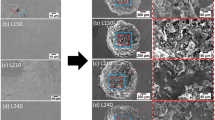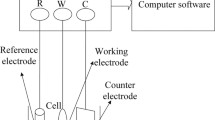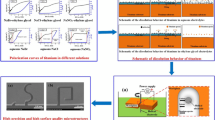Abstract
Titanium alloys are widely used in the aerospace and biomedical industries. Micro-dimple arrays, as a kind of surface texture, have been applied on titanium alloy surfaces to enhance tribological behaviour as well as to affect the biological performance of titanium implants. Through-mask electrochemical micromachining (TMEMM) is a promising approach to generate micro-dimple arrays on metal surfaces. In general, sodium bromide and methanol–sulfuric acid, which could dissolve the passive oxide layer on titanium alloy surfaces, are used as electrolytes to generate micro-dimple arrays. However, these electrolytes are caustic, which can damage the equipment, and are unfavourable for industrial applications. In this paper, an environmentally friendly NaNO3 electrolyte was employed to generate micro-dimple arrays on titanium alloy surfaces in TMEMM with a reusable mask; this made the process more efficient and safer. Experiments showed that there was serious stray corrosion on the titanium alloy surfaces when the micro-dimple arrays were generated using direct current. To obtain high-quality micro-dimple arrays, a pulsed current was employed in TMEMM. The results showed that machining parameters of applied voltage of 24 V, pulse duty cycle of 10 % and frequency of 100 Hz were appropriate to improve the machining quality. Micro-dimple arrays with no stray corrosion were thus generated. Moreover, the electrolyte temperature also influenced the machining accuracy, and a low electrolyte temperature of 20 °C was useful to reduce the undercutting of micro-dimples and improve machining localization. With the optimized parameters, micro-dimples with a diameter of 110 μm and depth of 20 μm were generated.
Similar content being viewed by others
References
Klocke F, Klink A, Veselovac D, Aspinwall DK, Soo SL, Schmidt M, Schilp J, Levy G, Kruth J-P (2014) Turbomachinery component manufacture by application of electrochemical, electro-physical and photonic processes. CIRP Ann Manuf Technol 63:703–726
Perez de Andrade D, Marotta Reis de Vasconcellos L, Chaves Silva Carvalho I, Ferraz De Brito Penna Forte L, de Souza Santos EL, Falchete Do Prado R, Dos Santos DR, Alves Cairo CA, Rodarte Carvalho Y (2015) Titanium-35niobium alloy as a potential material for biomedical implants: in vitro study. Mater Sci Eng C 56:538–544
Budinski KG (1991) Tribological properties of titanium alloys. Wear 151:203–217
Hu T, Hu L, Ding Q (2012) The effect of laser surface texturing on the tribological behavior of Ti-6Al-4V. Proc I Mech E Part J: J Eng Tribol 226:854–863
Vörös J, Wieland M, Ruiz-Taylor L, Textor M, Brunette DM (2001) Characterization of titanium surfaces. In: Brunette DM, Teng-vall P, Textor M, Thomsen P (eds) Titanium in medicine. Springer, Berlin, pp 87–144
Lin Z, Wang Y, Wang D, Zhao B, Li J (2013) Porous structure preparation and wettability control on titanium implant. Surf Coat Technol 228:S131–S136
Hotovy I, Kostic I, Nemec P, Predanocy M, Rehacek V (2015) Patterning of titanium oxide nanostructures by electron-beam lithography combined with plasma etching. J Micromech Microeng 25:074006
Dongqing H, Shaoxian Z, Jibin P, Guangan Z, Litian H (2015) Improving tribological properties of titanium alloys by combining laser surface texturing and diamond-like carbon film. Tribol Int 82:20–27
Datta M (1996) Electrochemical micromachining. In: Masuko M, Osaka T, Ito Y (eds) Electrochemical technology: innovation and new developments. Gordon and Breach Science Publishers, Tokyo, pp 137–158
Ahmmed TKM, Ling EJY, Servio P, Kietzig A-M (2015) Introducing a new optimization tool for femtosecond laser-induced surface texturing on titanium, stainless steel, aluminum and copper. Opt Lasers Eng 66:258–268
Lu X, Leng Y (2005) Electrochemical micromachining of titanium surfaces for biomedical applications. J Mater Process Technol 169:173–178
Madore C, Landolt D (1997) Electrochemical micromachining of controlled topographies on titanium for biological applications. J Micromech Microeng 7:270–275
Chauvy P-F, Hoffmann P, Landolt D (2003) Electrochemical micromachining of titanium using laser oxide film lithography: excimer laser irradiation of anodic oxide. Appl Surf Sci 211:113–127
Weinmann M, Stolpe M, Weber O, Busch R, Natter H (2015) Electrochemical dissolution behaviour of Ti90Al6V4 and Ti60Al40 used for ECM applications. J Solid State Electrochem 19:485–495
Qu NS, Fang XL, Zhang YD, Zhu D (2013) Enhancement of surface roughness in electrochemical machining of Ti6Al4V by pulsating electrolyte. Int J Adv Manuf Technol 69:2703–2709
Chen XL, Qu NS, Li HS, Zhu D (2014) The fabrication and application of a PDMS micro through-holes mask in electrochemical micromanufacturing. Adv Mech Eng 6:943092
Xu K, Zeng Y, Li P, Zhu D (2015) Study of surface roughness in wire electrochemical micro machining. J Mater Process Technol 222:103–109
Hung JC, Chang CH, Chiu KC, Lee SJ (2013) Simulation-based fabrication of micro-helical grooves in a hydrodynamic thrust bearing by using ECMM. Int J Adv Manuf Technol 64:813–820
Author information
Authors and Affiliations
Corresponding author
Rights and permissions
About this article
Cite this article
Chen, X., Qu, N. & Hou, Z. Electrochemical micromachining of micro-dimple arrays on the surface of Ti-6Al-4V with NaNO3 electrolyte. Int J Adv Manuf Technol 88, 565–574 (2017). https://doi.org/10.1007/s00170-016-8807-x
Received:
Accepted:
Published:
Issue Date:
DOI: https://doi.org/10.1007/s00170-016-8807-x




